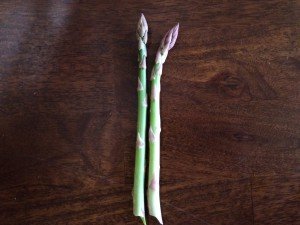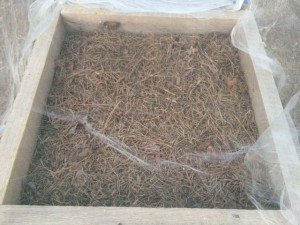I sometimes forget the prevailing notions people have related to growing food. The most common mental images seem to center around long hours of back breaking labor spent tilling, planting, hoeing and weeding.I am quickly reminded of the current thinking when I breezily say things like, "I planted 288 spinach plants today and need to do the same for lettuce tomorrow." and the person I am speaking with gapes in horror at the perceived amount of time and effort that goes into it. But the chasm between what they are thinking and what I actually did is as big as the Grand Canyon. We are operating under two VERY different paradigms when it comes to growing food...Depending on the agricultural model used, growing food can be relatively low-labor and the little time and money spent in the garden is subtracted directly from the time and money that would otherwise be spent driving to the grocery store, finding produce that is less nutritious and fresh, waiting in the checkout line to pay and then driving home on a daily or weekly basis.This morning I planted 36 Red Romaine lettuces and the whole process took about 20 minutes. I started with a homemade plant spacing tool made from plywood, cheap cabinet handles and recycled wine corks: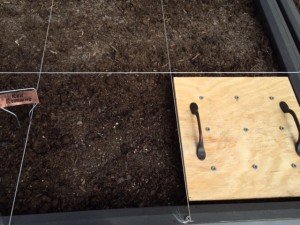
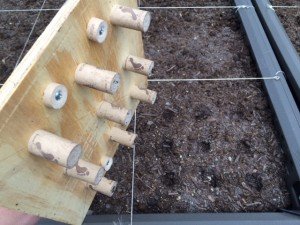 Lettuce can be planted 9 to a square foot so I pressed the spacer into 4 of my 1'x1' squares to leave divots where the seeds should be planted.Next I shook out some seed into my palm and placed 2 per divot. I normally have really good germination rates with the Baker Creek lettuce seeds, but these are last year's seeds so I did 2 to be safe. This was the most time intensive part of the whole operation but not what I would call laborious.
Lettuce can be planted 9 to a square foot so I pressed the spacer into 4 of my 1'x1' squares to leave divots where the seeds should be planted.Next I shook out some seed into my palm and placed 2 per divot. I normally have really good germination rates with the Baker Creek lettuce seeds, but these are last year's seeds so I did 2 to be safe. This was the most time intensive part of the whole operation but not what I would call laborious. When I was done I patted the soil over the seeds, lightly covering them and creating good dirt to seed contact then watered.
When I was done I patted the soil over the seeds, lightly covering them and creating good dirt to seed contact then watered.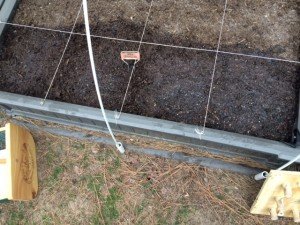 Voila!Yes there will be some watering throughout the season and yes, I do get an occasional volunteer plant that needs to be plucked out of my garden beds, but those are minor things, easily taken care of when I head out to my backyard grocery store each night and look around to see what's for dinner.
Voila!Yes there will be some watering throughout the season and yes, I do get an occasional volunteer plant that needs to be plucked out of my garden beds, but those are minor things, easily taken care of when I head out to my backyard grocery store each night and look around to see what's for dinner.
Batting 500
Then There Was One
This morning I did my final pass thinning the tomatoes, peppers, collards, cabbage and kale down to a single plant in each starter cup and then I crossed my fingers that no fungi or pests find my singletons between now and when they move outside.For now the 38 tomato plants are vigorous and hale and I am excited that fully half of them are from my own saved seed.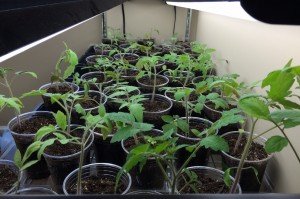 I added a few new varieties this year of both slicing and cherry tomatoes and plan to save seed from all I want to grow again next year.The cabbage and collards are nearly ready to be hardened off and will join the lettuce, spinach and leeks I will be direct sowing this weekend.
I added a few new varieties this year of both slicing and cherry tomatoes and plan to save seed from all I want to grow again next year.The cabbage and collards are nearly ready to be hardened off and will join the lettuce, spinach and leeks I will be direct sowing this weekend.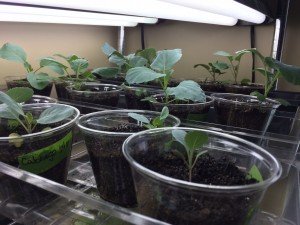 Now that the 2 week forecast has no nighttime temps below freezing it is time to get the spring garden into full swing!
Now that the 2 week forecast has no nighttime temps below freezing it is time to get the spring garden into full swing!
Urban Growing - By The Numbers
- 200% - the increase in households participating in community gardens from 2008 to 2013
- 35% - the number of households growing food at home or in a community garden
- 88% - the number of people that do not garden but still want to see gardens in their neighborhood
This data was excerpted from the excellent article "Urban Growing" by Christine Jordan Sexton, published on Realtor.org. There are many other interesting numbers in the article such as $1.2 billion being the amount millennials spent on food gardening in 2013 if you happen to be looking for a business opportunity or 750 being the number of mostly poor families helped by Southside Community Land Trust in Providence, RI to grow their own food if you happen to be looking for a way to give a hand up to those in need.But for me, it was the 88% of people wanting to see gardens in their neighborhood that do not garden themselves number that was most interesting. It's no surprise at all that gardeners like to see other gardens in their neighborhood, but it is news to me that people that do not garden also take pleasure in the sight of food growing in a neighborhood. Kudos to you 88%! C'mon over, I'll have some extra tomatoes in August :)
Don't Blink
During the past week of business travel my indoor plant starts have grown with the vigor of youth into a verdant and slightly unruly bunch of tweens.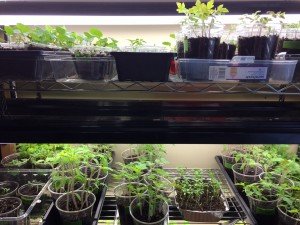 The tomatoes from my saved seed are particularly in need of thinning. I seeded them a little more thickly since I did not know what my germination rate would be. While they initially lagged about week behind fermented seeds I purchased this year, the germination rate for my saved seed looks to be close to 100%.
The tomatoes from my saved seed are particularly in need of thinning. I seeded them a little more thickly since I did not know what my germination rate would be. While they initially lagged about week behind fermented seeds I purchased this year, the germination rate for my saved seed looks to be close to 100%.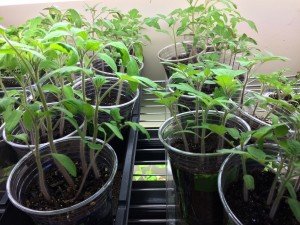 Pro Tip - always use scissors to snip off the plants you are thinning to avoid disturbing the roots of chosen specimen.
Pro Tip - always use scissors to snip off the plants you are thinning to avoid disturbing the roots of chosen specimen.
Fired Up For Summer
I know it's a bit early to be thinking about summer and fresh from the garden salsa, but the recipe below for Fire-Roasted (Cherry) Tomato Salsa from the very entertaining Chef John Mitzewich (Food Wishes) sent me back to my garden plan to make sure I plenty of cherry tomatoes started to enjoy this salsa all summer!My favorite recipes to make have at least some portion of the ingredients coming from my own garden and this one definitely fits the bill for being NearlyHomeGrown with cherry tomatoes, cilantro, oregano and serranos substituting for jalapenos as key ingredients.
Will Work For Food
The phrases urban agriculture and urban farming answer the where and the what, but not necessarily the why of food production. Some urban growers are producing for personal use (which could include sharing their excess bounty with friends, neighbors and coworkers) while other growers are producing food as part or all of their household income stream.While these two groups take very different approaches to growing, watching Curtis Stone's Profitable Urban Farming workshop intro showed me that the personal grower can learn from some of the strategies and efficiencies of the income grower. We are both working to grow food so a little cross pollination (pardon my pun) of ideas can be beneficial.In this 42 minute video he gives an overview of his commercially successful urban farm in Kelowna, BC. For income growers, there are a lot of interesting ideas presented. He has an innovative strategy for land acquisition that is essentially OPP, other people's property. He rents portions of front, back and side yards from homeowners in his city within a 1 1/4 mile of his home to grow his produce.A very interesting strategy he uses that can be adapted for personal growers is how he categorizes crops as either "quick" or "steady". Quick crops are crops that are ready to harvest in less than 60 days. Steady crops are those "cut and come again" crops that take longer but provide a more sustained harvest. With his 5 growing plots scattered across 1 1/4 mile, he grows his quick crops in the plots closest to him, since they need to be visited more often for planting, rotation and harvest. He plants his steady crops in the furthest plots to since they only need to be harvested once or twice per week.Personal growers can adapt this concept and plant their baby greens and lettuces in the part of their garden closest to the house and plant the squash and onions in the far part of the garden since they need less regular attention.For growers looking to build or expand their business, this video is packed with information. For personal growers, there are some great tips on layout, harvesting and drip irrigation that can be implemented in home gardens.In addition to this workshop intro video, he has a lot of other videos on his YouTube channel worth perusing for both income and personal growers.
City Farm
"What if we ingeniously enriched that vacant land with waste wood products, waste food products and had a rich farm, employed local people to produce the healthy foods that community needs?" - Ken Dunn, founder of Resource Center and City FarmCity Farm is doing all of that and more! City Farm subsidizes their direct sales to the public by contracting with local restaurants wanting fresh, local produce on their menus. City Farm then picks up the restaurant's food waste to be recycled into compost to feed the rich soil that will grow more food.The images in this video capture the beauty of this little agricultural oasis against the backdrop of the Chicago skyline:For a more in depth look at how City Farm is diverting urban waste to create fresh, sustainable food for the local community:In December, City Farm began moving from it's location at 1204 N Clybourn to a new lot one block to the west. Each summer I attend a conference in Chicago for a few days in August and I can't wait to see the new farm when I am there!
Hello, My Name Is...
This year will be my fifth year as an urban food grower. It will also be my fifth attempt to create plant markers that are still legible at the end of a growing season. With 52 varieties of annuals planned in addition to the handful of perennials that live in my garden, knowing who is who can be important. This is particularly true when it comes to saving seed.In previous years I have tried cheap plastic tags labeled with sharpee, which faded after just a few short months followed by the same plastic tags using pencil after reading the graphite would weather better than ink. They did not fade quite as much or as fast as the sharpee had, but were still hard to read after a few months of sun and rain. Next up was wine corks with sharpee thinking that the porous nature of the corks would absorb the ink better than the hard plastic had but which also faded into illegibility by mid season.For this year's garden I was determined to find something more lasting and attractive for my plant markers since the majority of these varieties will be planted year after year. I spent some time researching permanent plant markers and found these copper plate markers that can be inscribed with a pen and a bit of elbow grease.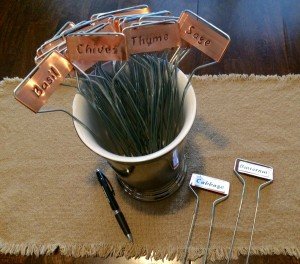 The initial cost to purchase and the time to label are certainly higher than my previous marker attempts but the end result is much more pleasing and should endure for many years to come.To inscribe the markers I printed out my varieties list in a nice, easily readable font. I laid the variety name printout over the copper plate and gently traced out the letters. I then removed the printout and used the pen to go over the letters directly on the copper plate until satisfied with the depth and thickness of the letters.
The initial cost to purchase and the time to label are certainly higher than my previous marker attempts but the end result is much more pleasing and should endure for many years to come.To inscribe the markers I printed out my varieties list in a nice, easily readable font. I laid the variety name printout over the copper plate and gently traced out the letters. I then removed the printout and used the pen to go over the letters directly on the copper plate until satisfied with the depth and thickness of the letters.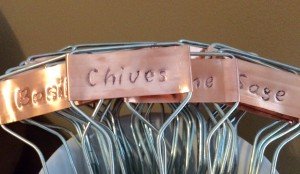 Each year my garden gets better and better #kaizen
Each year my garden gets better and better #kaizen
Countdown to Garden 2016
Even before presents are unwrapped, the countdown is on with less than a month to go before indoor starts of cabbage, leeks and rosemary get going in the first part of January with peppers (hot and bell) just behind.So I've been making my list and checking it twice this week to see what varieties will make it into my 219 square foot of garden space for 2016.I am making heavy use of containers for herbs (and one lettuce I just couldn't resist) and also using two composted trenches in the yard to grow The Three Sisters: corn, blackeyed peas and decorative squash. I currently have 8 1x1 boxes for cucurbits, but will be adding in 3 more before spring to hold all the zucchini, squash and cucumbers on my list.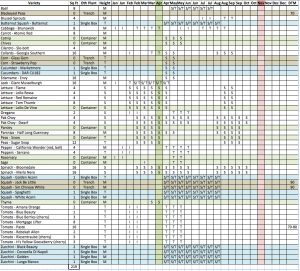 Despite planning 52 different varieties of annuals for next year, my 2016 seed order (including shipping) came in under $42. This economy was mostly due to saving more of my own seed this year than ever before and having plenty of unused 2015 seed for most of what I plan to grow next year - Square Foot Gardening makes better use of individual seeds than row gardening so more seeds are conserved for future use.
Despite planning 52 different varieties of annuals for next year, my 2016 seed order (including shipping) came in under $42. This economy was mostly due to saving more of my own seed this year than ever before and having plenty of unused 2015 seed for most of what I plan to grow next year - Square Foot Gardening makes better use of individual seeds than row gardening so more seeds are conserved for future use.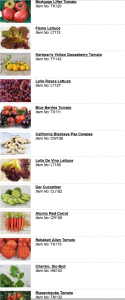 One of my splurge purchases for this year was the Slo-Bolt Cilantro. I am still drawing down the huge supply of cilantro/coriander seeds saved from my 2012 garden. They still have a high germination rate so I have been using them for both outdoor garden and microgreen plantings since then. If the slo-bolt lives up to its name, my 2012 cilantro has had its last reproductive cycle and will be only for microgreens and I will switch to saving the slo-bolt seed.Next I will start plotting out the placement of these plantings on my garden map. 2015 was my first full garden cycle in Raleigh and the biggest lesson was that maximizing light has to be a priority for north facing gardens further complicated by some tree shade. To that end, I added a height column with each plant ranked Short, Medium or Tall to plan my garden for next year. Tallest plants in to the north and shortest plants to the south has always been the rule of thumb but is now a requirement for my future garden plans which will make crop rotations a little more challenging.It is damp, but in the low-mid 70's this weekend, so I will also spend some time putting in new grids into my raised beds. I have been using kitchen string for the past few years but the cottony string only lasts one year before stretching, breaking and needing to be replaced. This year I am going to try a white nylon string that is made for outdoor use and hope it holds up better.Here's to a wonderful close to 2015 and a bright start to 2016! Happy Holidays!
One of my splurge purchases for this year was the Slo-Bolt Cilantro. I am still drawing down the huge supply of cilantro/coriander seeds saved from my 2012 garden. They still have a high germination rate so I have been using them for both outdoor garden and microgreen plantings since then. If the slo-bolt lives up to its name, my 2012 cilantro has had its last reproductive cycle and will be only for microgreens and I will switch to saving the slo-bolt seed.Next I will start plotting out the placement of these plantings on my garden map. 2015 was my first full garden cycle in Raleigh and the biggest lesson was that maximizing light has to be a priority for north facing gardens further complicated by some tree shade. To that end, I added a height column with each plant ranked Short, Medium or Tall to plan my garden for next year. Tallest plants in to the north and shortest plants to the south has always been the rule of thumb but is now a requirement for my future garden plans which will make crop rotations a little more challenging.It is damp, but in the low-mid 70's this weekend, so I will also spend some time putting in new grids into my raised beds. I have been using kitchen string for the past few years but the cottony string only lasts one year before stretching, breaking and needing to be replaced. This year I am going to try a white nylon string that is made for outdoor use and hope it holds up better.Here's to a wonderful close to 2015 and a bright start to 2016! Happy Holidays!
December Morning on the (Urban) Farm
 Some keep the Sabbath going to the ChurchI keep it, staying at HomeWith a Bobolink for a ChoristerAnd an Orchard, for a Dome
Some keep the Sabbath going to the ChurchI keep it, staying at HomeWith a Bobolink for a ChoristerAnd an Orchard, for a Dome
Some keep the Sabbath in SurpliceI just wear my WingsAnd instead of tolling the Bell, for Church,Our little Sexton sings.
God preaches, a noted ClergymanAnd the sermon is never long,So instead of getting to Heaven, at lastI’m going, all along. ~ Emily Dickinson
Mornings like this never fail to bring the words this poem that I loved since I was a young girl to mind. The beauty of the rising sun was rivaled by the sunset colors of the blueberry leaves all decked out in their fall colors. And the tender green leaves of the Tom Thumb lettuce growing in a container on my deck made the morning feel more like a late spring day than a warm winter one.
And the tender green leaves of the Tom Thumb lettuce growing in a container on my deck made the morning feel more like a late spring day than a warm winter one.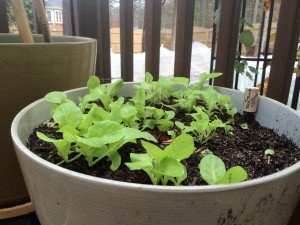 Now, if I just had that orchard dome...
Now, if I just had that orchard dome...
Trench Composting for Corn
I have never really wanted to grow corn since the small amounts I desire for home cooking are readily available at the farmer's market in season, it takes up a lot of valuable space in an already tight garden plan and it is an environmentally costly plant to grow. Corn is greedy. Really greedy.Then I promised my 8 year old that he could grow anything he wanted next year and flipping through a seed catalog he picked Strawberry Popcorn. I dutifully ordered the seeds and we were researching growing, harvesting and drying the variety online when we ran across our first glimpses of Glass Gem Corn. We marveled at the photos and videos of this varietal and were both smitten by its beautiful colors. When it appeared on the Baker Creek Heirloom cover a couple of weeks ago, I found myself suddenly preparing for two varieties of corn in spring 2016 but still didn't want corn in my garden proper.My suburban lawn is in its second year of organic management (no herbicides, pesticides or fertilizers are used) so the conundrum of what to do with the corn made me consider planting directly in the yard as a solution to the space requirements and soil depletion problems of corn. But although I don't use chemicals on the soil, that is not the same thing as having good, rich soil for growing anything. I had seen information on trench composting some time ago and decided to dig back in and learn a bit more.There are a lot of variations on trench composting from the fill it as you go style to the much more elaborate hugelkultur style installations. I opted for something closer to the style in the video below.https://www.youtube.com/watch?v=W1XmP9-RpmYI started with a trench and filled in a layer of browns. These are leaves and pine needles that have been composting for a year now. The leaves have already broken down into a rich soil structure but the pine needles take a bit longer.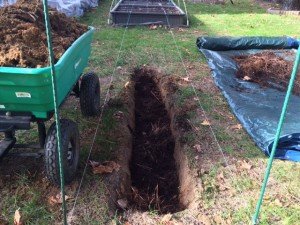 I followed the layer of browns with some rich, dark, nearly done compost from my two tumbling composters.
I followed the layer of browns with some rich, dark, nearly done compost from my two tumbling composters.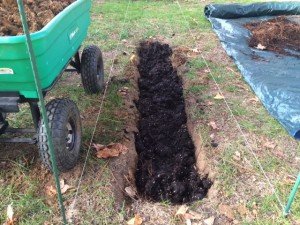 I topped the compost with another layer of the browns.
I topped the compost with another layer of the browns.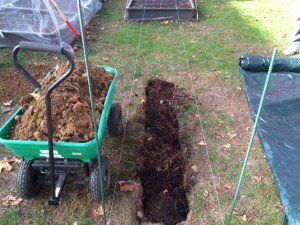 And finished it off by replacing a top layer of soil, mounding it up a bit since it will settle as the layers of browns and compost continue to biodegrade and compact.
And finished it off by replacing a top layer of soil, mounding it up a bit since it will settle as the layers of browns and compost continue to biodegrade and compact.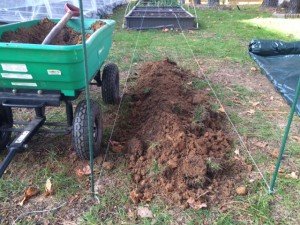 The Glass Gem Corn will be planted on either side of this trench in spring and I will need to do the same elsewhere in my yard for the Strawberry Popcorn. I hope to have a staggered planting system in years ahead where I grow on top of a trench a year and a half after it is filled with rich, organic matter that has had time to be broken down by microbial and worm activity.
The Glass Gem Corn will be planted on either side of this trench in spring and I will need to do the same elsewhere in my yard for the Strawberry Popcorn. I hope to have a staggered planting system in years ahead where I grow on top of a trench a year and a half after it is filled with rich, organic matter that has had time to be broken down by microbial and worm activity.
Winter Growing
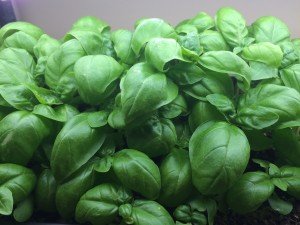 This winter there will be a lot of focus on my indoor gardens mostly because my outdoor winter garden is a bit of a bust this year. The collards and spinach I planted were just beginning to grow when an unseasonable cold-snap halted them in their tracks. I tried resowing but still don't have much of anything green going on outside. I haven't given up completely on the 3 inch tall collards that I still hope will be served on New Years, but accept that I may be buying most of my good luck meal this year instead of growing it.Right now my indoor garden consists of two trays of basil microgreens (already harvesting from the tray on the left) and 8 pots of basil that will be allowed to grow into full plants of about 8" tall and pruned a bit daily as needed for meals.
This winter there will be a lot of focus on my indoor gardens mostly because my outdoor winter garden is a bit of a bust this year. The collards and spinach I planted were just beginning to grow when an unseasonable cold-snap halted them in their tracks. I tried resowing but still don't have much of anything green going on outside. I haven't given up completely on the 3 inch tall collards that I still hope will be served on New Years, but accept that I may be buying most of my good luck meal this year instead of growing it.Right now my indoor garden consists of two trays of basil microgreens (already harvesting from the tray on the left) and 8 pots of basil that will be allowed to grow into full plants of about 8" tall and pruned a bit daily as needed for meals.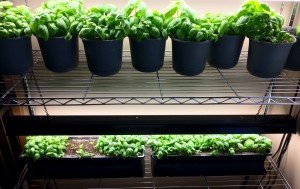 I will be starting another 3 trays of cilantro microgreens this weekend and will do various other types of microgreens (arugula, mustard and red cabbage) off and on all winter to add some homegrown flavor and crunch to winter meals.If you are considering indoor growing, microgreens have a lot going for them. They have a very quick turn around, usually only 2-4 weeks from beginning to end which is basically instant gratification in the gardening world. And due to their fast germination to harvest cycle, they aren't usually around long enough for pests and diseases to become an issue.These little plants really do have some powerful flavor, often even more than their adult versions and growing research from reputable sources is showing that some of them are packed with up to 5x the vitamins and carotenoids found in the adult versions of the same plants.So whether or not my outdoor garden takes off with this wonderfully sunny and warm week we are having, I will be posting (and eating) fresh all winter long.
I will be starting another 3 trays of cilantro microgreens this weekend and will do various other types of microgreens (arugula, mustard and red cabbage) off and on all winter to add some homegrown flavor and crunch to winter meals.If you are considering indoor growing, microgreens have a lot going for them. They have a very quick turn around, usually only 2-4 weeks from beginning to end which is basically instant gratification in the gardening world. And due to their fast germination to harvest cycle, they aren't usually around long enough for pests and diseases to become an issue.These little plants really do have some powerful flavor, often even more than their adult versions and growing research from reputable sources is showing that some of them are packed with up to 5x the vitamins and carotenoids found in the adult versions of the same plants.So whether or not my outdoor garden takes off with this wonderfully sunny and warm week we are having, I will be posting (and eating) fresh all winter long.
Store Bought Reboot - Regrowing Veggies
Here at NearlyHomeGrown, food scraps usually end up being frozen for future vegetable and/or chicken stocks or composted to feed the next generation of growing food. But I have been interested in the regrowing veggies craze and finally had the perfect reason to try it.The latest shiitake flush resulted in 7.7 oz of fresh mushrooms and they have been going into almost every meal in one way or another, but especially into homemade ramen noodle soup where they are a headliner ingredient. One of the other ingredients, the scallions, have been something of a philosophical splurge for this autumnal meal. They are store bought, out-of-season produce that I could live without but really didn't want to because of the flavor and color they add to the dish...and voila! The perfect vegetable to try regrowing!
One of the other ingredients, the scallions, have been something of a philosophical splurge for this autumnal meal. They are store bought, out-of-season produce that I could live without but really didn't want to because of the flavor and color they add to the dish...and voila! The perfect vegetable to try regrowing!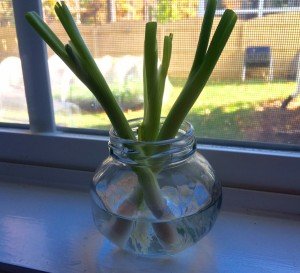 The green onion ends were pulled from the cooking scrap pile destined for stock making and put into a clear jar with fresh water and placed in a sunny window. The water will need to be changed every other day between now and spring when I will try planting them in my outdoor garden. In the meantime I can continue to steal the green tops for ramen soup and other dishes while keeping the root alive and growing.
The green onion ends were pulled from the cooking scrap pile destined for stock making and put into a clear jar with fresh water and placed in a sunny window. The water will need to be changed every other day between now and spring when I will try planting them in my outdoor garden. In the meantime I can continue to steal the green tops for ramen soup and other dishes while keeping the root alive and growing.
Glass Gem Corn
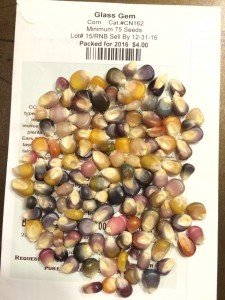 It's not often that a packet of seeds is so exciting that I cannot wait until spring to open the flap and take a peek inside. Glass Gem corn is a clear exception!The Glass Gem heirloom corn variety hit the homegrown stage a few years ago and has been offered only on a wait-list basis from very limited outlets until now. So when I saw the cover of the 2016 Baker Creek Heirloom Seeds catalog I assumed they were just highlighting a very photogenic variety for the cover. When I discovered they were actually carrying the seed, I didn't hesitate and am now planning where to plant the star of my 2016 garden!
It's not often that a packet of seeds is so exciting that I cannot wait until spring to open the flap and take a peek inside. Glass Gem corn is a clear exception!The Glass Gem heirloom corn variety hit the homegrown stage a few years ago and has been offered only on a wait-list basis from very limited outlets until now. So when I saw the cover of the 2016 Baker Creek Heirloom Seeds catalog I assumed they were just highlighting a very photogenic variety for the cover. When I discovered they were actually carrying the seed, I didn't hesitate and am now planning where to plant the star of my 2016 garden!
Quest For Fire
My tomatoes were troopers this year holding onto green romas, blue beauties and red delicious globes into early November, but I gave up and pulled the remainders two weeks ago just so I could begin cleaning the beds and preparing them for winter before heading off to a week's worth of meeting in San Diego last week.This weekend's task was to pull the rest of the serranos off before 3 consecutive nights of freezing or below temperatures hit them. My final harvest ended up being 1lb, 5oz of beautiful peppers that will warm dishes from now until next year. All were cleaned and vaccu-sealed before being frozen except for a few that will go into the Thanksgiving cornbread later this week.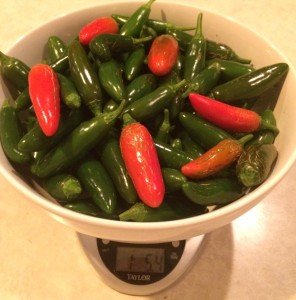 On another pepper note, a friend has some seeds that he will be sharing with me from his home country of El Salvador. I am keenly interested in growing them out next year since he doesn't know the name of them in either his native tongue or English. For now I am thinking of them as Mystery Pepper and what a fun mystery to solve!
On another pepper note, a friend has some seeds that he will be sharing with me from his home country of El Salvador. I am keenly interested in growing them out next year since he doesn't know the name of them in either his native tongue or English. For now I am thinking of them as Mystery Pepper and what a fun mystery to solve!
Growing Sustainability - Part 2
In Growing Sustainability - Part 1 I lauded the War Commission Gardens and Victory Gardens for what they grew, a lot of food and a more self-sufficient citizenry. At their height, over 20,000,000 Victory Gardens dotted the American landscape and in 1944, they were producing 40% of all the vegetables grown in the US. These small scale but widespread gardens and orchards contributed to the food landscape in many subtle ways beyond just the food produced on them. A diversity of growers and a diversity of what is grown seems to go hand-in-hand.This startling illustration by the Rural Advancement Foundation International-USA depicts the realities of our dwindling agricultural biodiversity with a sampling of the commercially available varieties of 10 commonly grown vegetable seeds from seed houses in 1903 at the top of the chart and the dramatic reduction in varieties of those same vegetables at the National Center for Genetic Resources Preservation just 80 years later.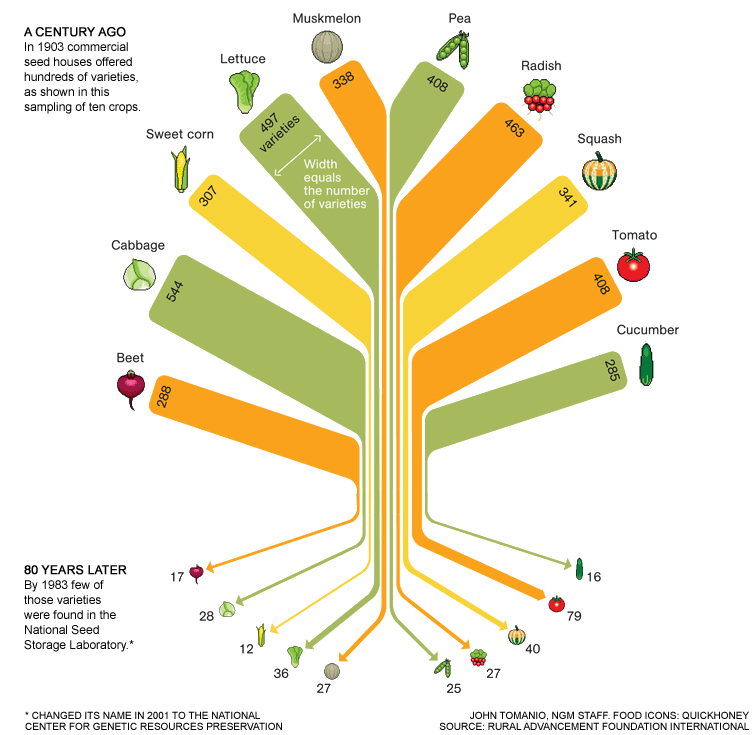 And it is not just the 1o varieties shown above that are at risk - this article by National Geographic puts the estimated diversity loss of all historic fruits and vegetables for the US at 90% while this Food and Agriculture Organization of the United Nations article puts the total global decrease of plant diversity at 75% in the last century.But there is good news in the What's For Dinner in 2025 discussion as well. Recessions spur backyard growing in a big way because growing your own food is cheaper than buying it. And this last recession happened in the age of the internet! How to plant, grow and harvest videos populate YouTube and sites like Garden Girl TV. Online seed houses for heirloom and open pollinated seeds have exploded in number and serve to connect the growers to a growing variety of available seeds. Two of my favorites are Baker Creek Heirloom Seeds and Seed Savers Exchange. Countless rural and urban farmers have blogs and vlogs, sharing their successes and failures and creating online communities that are (excuse the pun) growing.Whether the online/rural/suburban/urban agricultural movement of people growing food where ever they live will be able to sustain itself over the long haul is anyone's guess. So a further bit of good news for future agricultural diversity is that Cary Fowler, along with the Consultative Group on International Agricultural Research (CGIAR) created the Svalbard Global Seed Vault to serve as a salt mine style back up of seeds from gene banks all over the world.Every minute of Cary's charming, engaging, sometimes scary* and ultimately uplifting 2009 TED Talk is worth watching!* At the 8:30 mark he talks about the the extremely limited time (2 breeding cycles) that plant breeders have to get corn ready for the climate of 2030. In the context of today's GMO headlines, it is easy to forget that injecting genes into a food crop does not make "food". It makes a plant organism that still has to grow to sexual maturity, be crossed with another plant to even get the first round of seed to test.
And it is not just the 1o varieties shown above that are at risk - this article by National Geographic puts the estimated diversity loss of all historic fruits and vegetables for the US at 90% while this Food and Agriculture Organization of the United Nations article puts the total global decrease of plant diversity at 75% in the last century.But there is good news in the What's For Dinner in 2025 discussion as well. Recessions spur backyard growing in a big way because growing your own food is cheaper than buying it. And this last recession happened in the age of the internet! How to plant, grow and harvest videos populate YouTube and sites like Garden Girl TV. Online seed houses for heirloom and open pollinated seeds have exploded in number and serve to connect the growers to a growing variety of available seeds. Two of my favorites are Baker Creek Heirloom Seeds and Seed Savers Exchange. Countless rural and urban farmers have blogs and vlogs, sharing their successes and failures and creating online communities that are (excuse the pun) growing.Whether the online/rural/suburban/urban agricultural movement of people growing food where ever they live will be able to sustain itself over the long haul is anyone's guess. So a further bit of good news for future agricultural diversity is that Cary Fowler, along with the Consultative Group on International Agricultural Research (CGIAR) created the Svalbard Global Seed Vault to serve as a salt mine style back up of seeds from gene banks all over the world.Every minute of Cary's charming, engaging, sometimes scary* and ultimately uplifting 2009 TED Talk is worth watching!* At the 8:30 mark he talks about the the extremely limited time (2 breeding cycles) that plant breeders have to get corn ready for the climate of 2030. In the context of today's GMO headlines, it is easy to forget that injecting genes into a food crop does not make "food". It makes a plant organism that still has to grow to sexual maturity, be crossed with another plant to even get the first round of seed to test.
To Buy or Not To Buy, That is the Question (Dal Fry)
Each year between September and January the question of "what to grow" must be asked and answered by growers everywhere. This is the time of year when seeds are carefully saved, seed catalogs are perused and garden plans begin to be sketched out for the following year.Asking and answering the question of what to grow necessarily means also answering the question of what not to grow, i.e. "what to buy" the following year with the answer being - everything else.Wendell Berry spoke eloquently on the consumer side of agriculture with his often cited quote, "Eaters must understand that eating takes place inescapably in the world, that it is inescapably an agricultural act, and that how we eat determines, to a considerable extent, how the world is used." So this answer to "what to buy" is in many ways, just as important as what we chose grow.Consumers are considering this question of the provenance of our food more often today and answering it from a variety of perspectives such as the locally-seasonally available movements to reduce food miles like the 100 Mile Diet (and its many variations), the Fair Trade movement and the certified organic movement. We are setting personal standards and restrictions on what we can and will purchase.Though it doesn't have a name or a label, another way to look at growing vs. purchasing locally from other growers vs. purchasing locally after being transported from across the globe is to consider the water content. Fruits and vegetables in particular have incredibly high water content and shipping this water across the world with fossil fuels comes at enormous environmental impact.Foods that are high in water content are highly perishable so the varieties grown are selected for their ability to withstand the journey, not for their flavor or nutrition. The perpetual summer these commercially grown and shipped varieties create in our grocery stores crowds out consumer demand for locally grown produce when it is in season, impacting the number of US family farmers that can make a living growing food.So which foods make a great planned buying list? Outside of locally grown fruits and vegetables, purchased from local farmers when they are in season, buying dried foods which are light and unlikely to be damaged in transport compared to high-water foods helps keep local farmers farming and reduces the need to ship water from one part of the globe to another. Rice, wheat, oats and other grains as well as beans, lentils and pasta are all high in nutrition, lightweight compared to water heavy fruits and vegetables, have a long shelf-life and the water gets added by you when you are ready to use them.A few months ago I wanted to try making a dal fry (a Punjabi lentil dish) and found this great crock pot recipe for toovar dal fry over at The Novice Housewife which I made with only one modification - I added the tomatoes at the end of cooking the dish, not the beginning.The dal fry was fantastic and I wanted to investigate growing lentils myself. I quickly learned that the lentils used in the dish cannot be grown in my humid area so were not a candidate for future garden plans, but since they are a dried and nutritious food as well as being delicious, dal fry will remain on my menu.
Variations On A Theme - Potato Leek Soup
My favorite recipes are the ones that resemble a good canvas - a delicious backdrop that can be accentuated and modified by what is in season and/or on hand. Having just finished a post about an overabundance of serrano peppers, I wanted to do a variation on a fall favorite - potato leek soup.This year's leeks are on the thin side which I attribute to my north facing backyard garden, so I harvested roughly 3x the number I would normally use for this recipe.
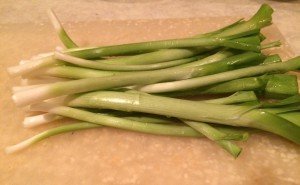 I decided to add some kick to the background canvas and finely chopped 4 roasted red serranos from my freezer and fresh oregano.
I decided to add some kick to the background canvas and finely chopped 4 roasted red serranos from my freezer and fresh oregano.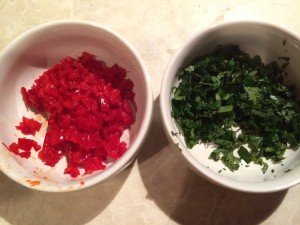
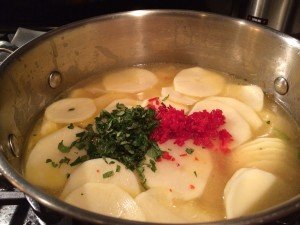 On it's own, this soup is mild but hearty making it a perfect backdrop for any number of flavor profiles.
On it's own, this soup is mild but hearty making it a perfect backdrop for any number of flavor profiles. The genius of this soup is the mandolin sliced potatoes.
The genius of this soup is the mandolin sliced potatoes.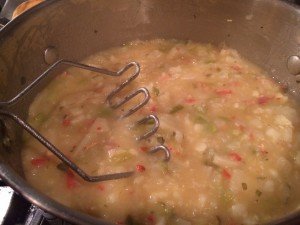 Once cooked through and gently mashed, they thicken the stock and the mashing breaks the potatoes into bite-sized pieces.
Once cooked through and gently mashed, they thicken the stock and the mashing breaks the potatoes into bite-sized pieces.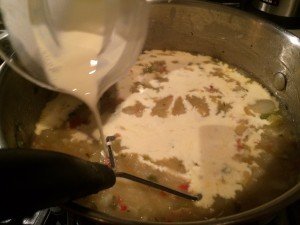 Add a little cream and cook on low for a few more minutes and voila!
Add a little cream and cook on low for a few more minutes and voila!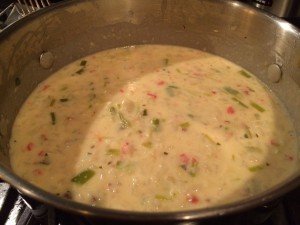 A delicious meal that varies depending on preferences and additions!
A delicious meal that varies depending on preferences and additions!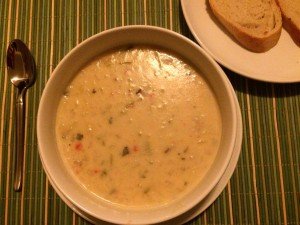
A Fungus Among Us
It is the time of year when harvests from the garden begin to taper off, Halloween decorations go up and a girl's thoughts turn to fungus. It was this time last year that I was trying my hand at growing shiitakes on my breakfast bar.With the success of last year's shiitakes under my belt, I wanted to expand my repertoire this year and grow some Elm Oyster Mushrooms also.My first grow out of my box kit was productive and I am resting the kit for it's second grow now.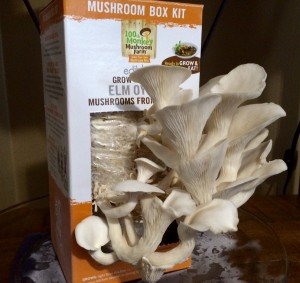 The 'grow your own mushrooms from a kit market' has exploded in the past couple of years and there are many great vendors out there, but I have to give a shout out to the wonderful and personal customer service from 100th Monkey Mushrooms. I love the helpful videos, the quick and helpful response via email for questions and their outstanding customer service - when I placed my order online for my Shiitake blocks and the Elm Oyster box a couple of weeks ago, Jimm called to let me know that the Shiitakes would not ship for another month and to see if I wanted to receive them together or separately.I am still waiting to see what (if anything) will happen with the 2 morel kits I ordered from Gourmet Mushrooms last fall. The information on the website and included with the kits' instructions said to not really expect a harvest until the second year which is finally less than six months away! I have been diligently adding compostable organic material to their separate 2'x2' raised beds to feed the mycelium for a year and a half and have my fingers crossed that in spring 2016 I will have the Holy Grail of forage mushrooms growing in my backyard!
The 'grow your own mushrooms from a kit market' has exploded in the past couple of years and there are many great vendors out there, but I have to give a shout out to the wonderful and personal customer service from 100th Monkey Mushrooms. I love the helpful videos, the quick and helpful response via email for questions and their outstanding customer service - when I placed my order online for my Shiitake blocks and the Elm Oyster box a couple of weeks ago, Jimm called to let me know that the Shiitakes would not ship for another month and to see if I wanted to receive them together or separately.I am still waiting to see what (if anything) will happen with the 2 morel kits I ordered from Gourmet Mushrooms last fall. The information on the website and included with the kits' instructions said to not really expect a harvest until the second year which is finally less than six months away! I have been diligently adding compostable organic material to their separate 2'x2' raised beds to feed the mycelium for a year and a half and have my fingers crossed that in spring 2016 I will have the Holy Grail of forage mushrooms growing in my backyard!
